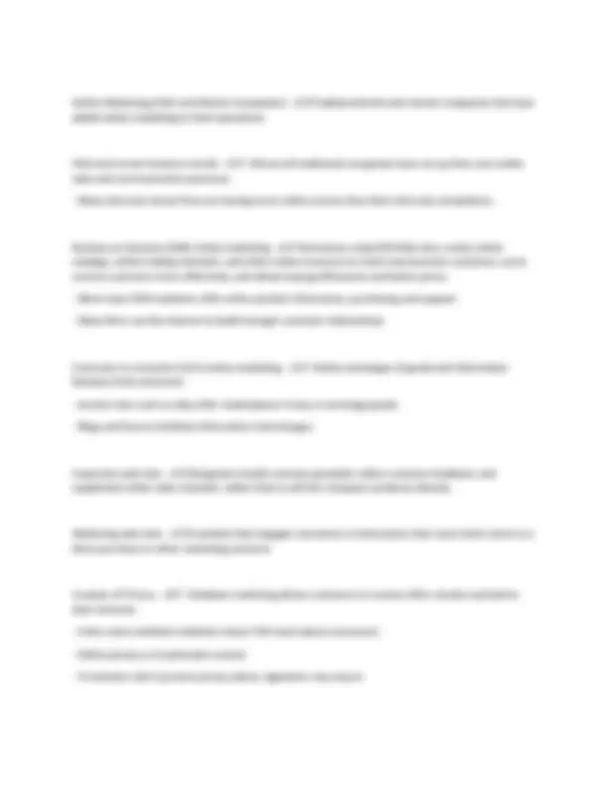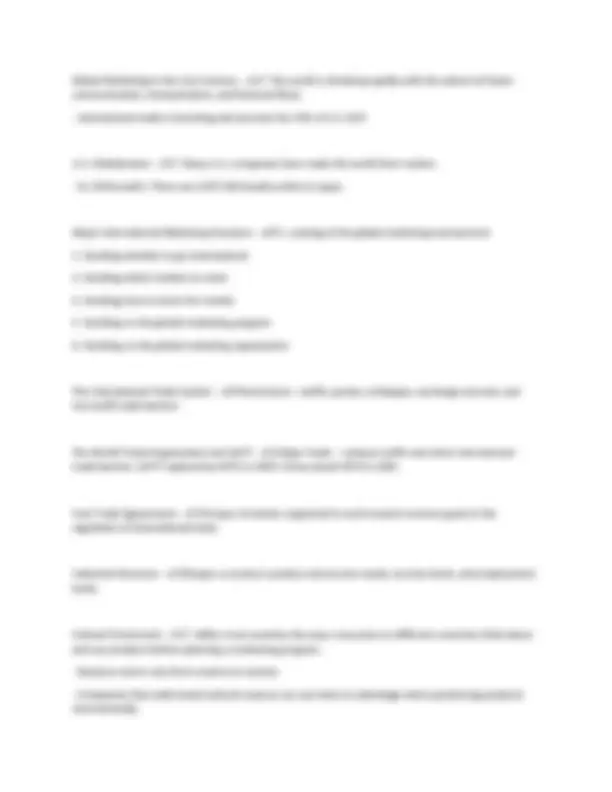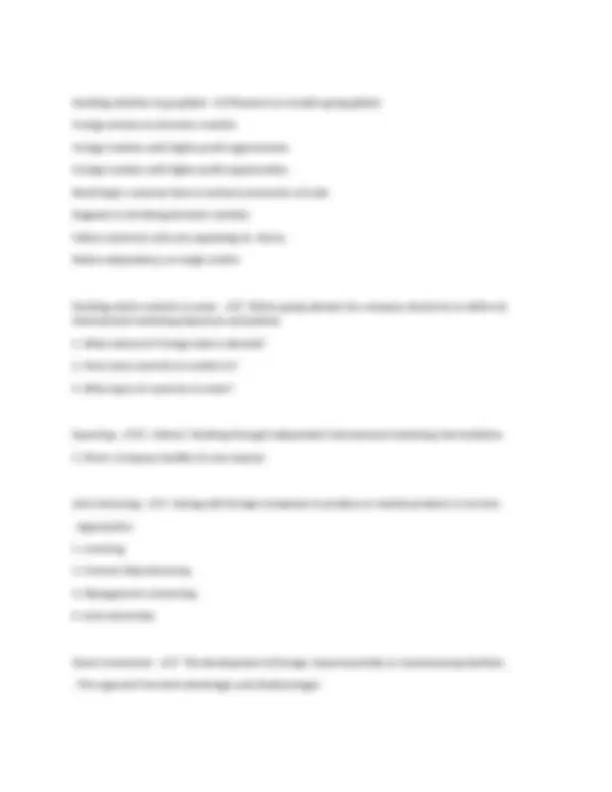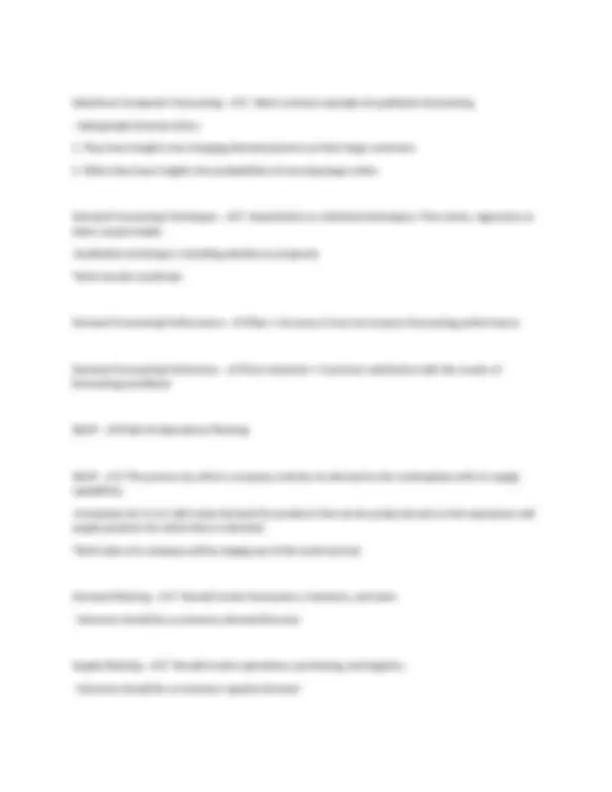Download Direct and Global Marketing: Comprehensive Q&A for Business Students and more Exams Marketing in PDF only on Docsity!
BUAD 332 Exam 4 | Comprehensive Questions and Answers Latest Updated 2025/2026 With 100% Verified Solutions Direct Marketing - ✔✔Connecting directly with carefully targeted individual consumers to both obtain an immediate response and cultivate lasting customer relationships New Direct-Marketing Model - ✔✔1. Direct marketing has undergone a dramatic transformation.
- Most firms use direct marketing as a supplemental channel or medium.
- For many companies, direct marketing constitutes a new and complete model for doing business.
- Some firms employ the direct model as their ONLY approach Growth of Direct Marketing - ✔✔1. Fastest growing form of marketing
- 10% of U.S. economy ($2.1 trillion) is generated by direct marketing sales.
- Direct marketing continues to become more Web-oriented and Internet marketing is the fastest- growing form of direct sales. Forms of Direct Marketing - ✔✔1. Face-to-face selling
- Direct-mail marketing
- Catalog marketing
- Telemarketing
- Direct-response television marketing
- Kiosk marketing
- New digital technologies
- Online marketing Direct-Mail Marketing - ✔✔- Involves sending an offer, announcement, reminder, or other item to a person at a particular physical or virtual address.
- Largest direct marketing medium
- Well-suited to one-to-one communication. -Use of traditional forms may decline as marketers switch to newer digital forms.
-Can be used effectively in combination with other media, such as web sites -Often perceived as junk mail Catalog Marketing - ✔✔- Direct marketing through print, video, or digital catalogs that are mailed to select customers, made available in stores, or presented online.
- More and more catalogs are going digital. -Print catalogs are still the primary medium Telephone marketing - ✔✔- Accounts for 17% of all direct-marketing driven sales.
- Used in both consumer and B2B markets.
- Marketers use outbound and inbound calls. -Do-not-call legislation has impacted the telemarketing industry. Outbound - ✔✔Sell directly to consumer Inbound - ✔✔Toll-free ordering or order faxing New digital Technologies - ✔✔Mobile phone marketing: mobile ad spending is expected to grow Online Marketing - ✔✔- Company efforts to market products and services and build customer relationships over the internet. Online Marketing (Click-only companies) - ✔✔Click-only companies: So called dot-coms, which operate only online without any brick and mortar presence
- Types of click-only firms:
- E-tailers (Amazon)
- Search engines and portals
- Transactions sites (eBay)
- Content sites (ESPN)
Global Marketing in the 21st Century - ✔✔- The world is shrinking rapidly with the advent of faster communication, transportation, and financial flows.
- International trade is booming and accounts for 25% of U.S. GDP. U.S. Globalization - ✔✔- Many U.S. companies have made the world their market.
- Ex: McDonald's. There are 2,975 McDonald outlets in Japan. Major International Marketing Decisions - ✔✔1. Looking at the global marketing environment
- Deciding whether to go international
- Deciding which markets to enter
- Deciding how to enter the market
- Deciding on the global marketing program
- Deciding on the global marketing organization The International Trade System - ✔✔Restrictions-- tariffs, quotas, embargos, exchange controls, and non-tariff trade barriers The World Trade Organization and GATT - ✔✔Helps Trade -- reduces tariffs and other international trade barriers. GATT replaced by WTO in 1995. China joined WTO in 2001 Free Trade Agreements - ✔✔Groups of nations organized to work toward common goals in the regulation of international trade. Industrial Structure - ✔✔Shapes a country's product and service needs, income levels, and employment levels Cultural Enviroment - ✔✔- Sellers must examine the ways consumers in different countries think about and use products before planning a marketing program.
- Business norms vary from country to country
- Companies that understand cultural nuances can use them to advantage when positioning products internationally.
Deciding whether to go global - ✔✔Reasons to consider going global: Foreign attacks on domestic markets Foreign markets with higher profit opportunities Foreign markets with higher profit opportunities Need larger customer base to achieve economies of scale Stagnant or shrinking domestic markets Follow customers who are expanding Ex: Denso Reduce dependency on single market Deciding which markets to enter - ✔✔- Before going abroad, the company should try to define its international marketing objectives and policies
- What volume of Foreign sales is desired?
- How many countries to market in?
- What types of countries to enter? Exporting - ✔✔1. Indirect: Working through independent international marketing intermediaries
- Direct: Company handles its own exports Joint Venturing - ✔✔- Joining with foreign companies to produce or market products or services
- Licensing
- Contract Manufacturing
- Management contracting
- Joint ownership Direct Investment - ✔✔- The development of foreign- based assembly or manufacturing facilities.
- This approach has both advantages and disadvantages
High Prices - ✔✔Caused by:
- High costs of distribution
- High Advertising and Promotion costs
- Excessive markups Deceptive Pricing - ✔✔Falsely advertisng "factory" or "wholesale" prices or large reductions from phony high retail list prices Deceptive Promotion - ✔✔Overstating a product's features or performances Deceptive Packaging - ✔✔Exaggerating package contents through subtle design, using misleading labeling High-Pressure Selling - ✔✔- Some salespeople are trained to deliver smooth, canned talks to entice purchase.
- Hard sales can occur because of prizes going to top sellers
- High-pressure selling not good for long-term relationships Planned Obsolescence - ✔✔- Products needing replacement before they should be obsolete.
- Producers change consumer concepts of acceptable styles.
- Intentionally holding back attractive functional features, then introducing them later to make old model obsolete Consumerism - ✔✔- Consumerism is an organized movement of citizens and government agencies to improve the rights and power of buyers in relation to sellers.
- Utilized a combination of legislation and the courts to protect consumer rights. Environmentalism - ✔✔- An organized movement of concerned citizens and government agencies to protect and improve people's living environment.
- Utilizing both legislation and the courts to influence corporate behavior Enlightened Marketing - ✔✔- A marketing philosophy holding that a company's marketing should support the best long-run performance of the marketing system Consumer-Oriented Marketing - ✔✔The philosophy of enlightened marketing that holds that the company should view and organize its marketing activities from the consumer's point of view. Innovative marketing - ✔✔A principle of enlightened marketing that requires that a company seek real product and marketing improvements Sense-of-Mission Marketing - ✔✔A principle of enlightened marketing that holds that a company should define its mission in broad social terms rather than narrow product terms. Demand - ✔✔Is what customers would buy from us if they could. This is unconstrained demand The demand forecast - ✔✔Is a projection into the future of expected demand, given a stated set of assumptions. This is an unconstrained forecast. Plans - ✔✔Are the managerial actions that result from the demand/supply integration process The forecasting level - ✔✔At what level of granularity is your forecast expressed? Product forecast Brand forecast SKU forecast The forecasting time horizon - ✔✔How far out into the future are you forecasting demand? The forecasting time interval - ✔✔How frequently do you update your forecast?
Salesforce Composite Forecasting - ✔✔- Most common example of qualitative forecasting
- Salespeople forecast when:
- They have insights into changing demand patterns at their large customers
- When they have insights into probabilities of securing large orders Demand Forecasting Techniques - ✔✔- Quantitative or statistical techniques: Time series, regression or other causal models -Qualitative techniques: including salesforce composite *Both should coordinate Demand Forecasting Performance - ✔✔Bias + Accuracy is how we measure forecasting performance Demand Forecasting Performace - ✔✔Cost reduction + Customer satisfaction tells the results of forecasting excellence S&OP - ✔✔Sales & Operations Planning S&OP - ✔✔-The process by which a company matches its demand in the marketplace with its supply capabilities -Companies do it so it will create demand for products that can be produced and so that operations will supply products for which there is demand. *Both sides of a company will be singing out of the same hymnal Demand Meeting - ✔✔- Should involve forecasters, marketers, and sales
- Outcome should be a consensus demand forecast Supply Meeting - ✔✔- Should involve operations, purchasing, and logistics.
- Outcome should be a consensus capacity forecast
Partnership Meeting - ✔✔- Should involve executives from both demand and supply sides, as will as finance
- Discussion should focus on balancing demand with supply
- Outcome should be agreed-upon demand plans and supply plans S&OP (tactical and strategic) - ✔✔Tactical: What should we make/sell in the next 1-6 months. Strategic: What are the longer term trends that will affect both demand and supply over 6-24 months




















